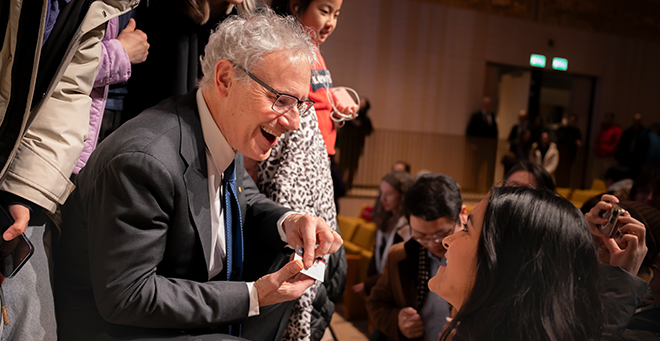
© Nobel Prize Outreach. Photo: Nanaka Adachi
Nobel Laureate Victor Ambros, PhD, delivered his Nobel Prize lecture in physiology or medicine before a packed house at the Swedish Academy in Stockholm over the weekend, while several hundred more watched online.
A central figure in ribonucleic acid (RNA) biology, Dr. Ambros, the Silverman Chair in Natural Sciences and professor of molecular medicine, shared the stage on Saturday, Dec. 7, with his longtime collaborator Gary B. Ruvkun, PhD, of Massachusetts General Hospital and Harvard Medical School. Ambros and Dr. Ruvkun were awarded the prize for their discovery of microRNA, the uniquely short, single-stranded RNA molecules that are now understood to be instrumental in post-transcriptional gene regulation.
Following a welcome and congratulations from the president of the Karolinska Institute by Annika Östman Wernerson, MD, PhD, Ambros was introduced by Anna Wedell, MD, PhD, a member of the Nobel Committee for Physiology or Medicine.
In her welcome, Dr. Östman Wernerson noted how the discovery of microRNA highlights the importance of curiosity-driven research. “The discovery of fundamental new mechanisms of gene regulation would probably not have been if goals for the research were predetermined,” she said.
Dr. Wedell explained that Ambros and Ruvkin, working together, managed to isolate the first microRNA gene, a painstaking task with the technology available at the time, which led to the surprising discovery that it encoded a tiny piece of RNA without a protein coding capacity.
“This resulted in a dramatic discovery moment when they realized that the tiny RNA was capable of astonishing things never heard of before,” she said.
Taking the stage, which was festively adorned with fresh pine trees decorated with white Christmas lights, Dr. Ambros began by dedicating his lecture to his wife and colleague Rosalind “Candy” Lee and Rhonda Feinbaum, PhD, his co-authors on the seminal 1993 paper describing lin-4, the first microRNA gene.
Ambros began his roughly 50-minute lecture by apologizing to the crowd for the long lines to get into the auditorium for the lecture. He then recounted his journey from his first forays into science as a teenager more than 50 years ago in 1970 when Sky and Telescope published his observations of the duration of shadow lines surrounding the total solar eclipse of March 7, 1970, to dropping a piano from the roof of his MIT dorm in 1971, to the experiments in 1993 that led to the discovery that lin-4 encoded for a small piece of RNA and not a protein.
He explained the serendipity involved in selecting lin-4 for study during a time when the technology available to scientists meant it could take five to six years to simply clone a gene, never mind identifying its genetic sequence and product. He mentioned the joy he felt of getting back into the lab and performing some early microRNA experiments when Dr. Feinbaum was on maternity leave.
He wrapped up the day’s lecture by telling the crowd how his lab’s work, published earlier this year in the Proceedings of the National Academy of Sciences, showed that the gene-silencing work of microRNA is disrupted by mutations associated with Argonaute syndromes. He explained how human mutations are now informing new studies into the basic biology of microRNA’s function.
“Argonaute syndrome is a very human phenomenon,” said Ambros. “It involves patients, families, clinicians, support teams and so forth, and it’s the patients that are gifting to us the identity of their mutations that allows us to do experiments, genetic or otherwise, and make inferences about fundamental mechanisms that are going to apply how Argonautes and microRNAs work in all sorts of contexts; but at the same time we’re hopeful and optimistic that we can learn enough from these studies to be able to inform the disease.”
Watch the 2024 Nobel Prize lectures in physiology or medicine.
Read more about Nobel Laureate Victor Ambros.

